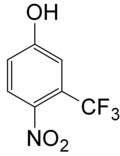This is an old revision of this page, as edited by CheMoBot (talk | contribs) at 20:23, 10 August 2011 (Updating {{chembox}} (no changed fields - added verified revid - updated 'DrugBank_Ref', 'UNII_Ref', 'ChEMBL_Ref', 'ChEBI_Ref', 'KEGG_Ref', 'StdInChIKey_Ref', 'ChEBI_Ref') per [[Misplaced Pages:WikiProject Chemicals/Chembox validation|Chem/Drugbox validati). The present address (URL) is a permanent link to this revision, which may differ significantly from the current revision.
Revision as of 20:23, 10 August 2011 by CheMoBot (talk | contribs) (Updating {{chembox}} (no changed fields - added verified revid - updated 'DrugBank_Ref', 'UNII_Ref', 'ChEMBL_Ref', 'ChEBI_Ref', 'KEGG_Ref', 'StdInChIKey_Ref', 'ChEBI_Ref') per [[Misplaced Pages:WikiProject Chemicals/Chembox validation|Chem/Drugbox validati)(diff) ← Previous revision | Latest revision (diff) | Newer revision → (diff)
| |
| Names | |
|---|---|
| IUPAC name 4-nitro-3-(trifluoromethyl)phenol | |
| Identifiers | |
| CAS Number | |
| 3D model (JSmol) | |
| ChemSpider | |
| ECHA InfoCard | 100.001.653 |
| PubChem CID | |
| CompTox Dashboard (EPA) | |
InChI
| |
SMILES
| |
| Properties | |
| Chemical formula | C7H4F3NO3 |
| Molar mass | 207.108 g·mol |
| Except where otherwise noted, data are given for materials in their standard state (at 25 °C , 100 kPa).
| |
TFM (3-trifluoromethyl-4-nitrophenol) is a common piscicide, i.e., a fish poison used to combat parasitic and invasive species of fish.
The substance was discovered in 1958 when researching means to combat sea lampreys and it currently remains the primary lampricide (lamprey-killer) in the Great Lakes area.
TFM is nontoxic to humans and other mammals. Impact on other fish species may be controlled by selective application during the larvae season for lampreys and other management of its concentration. TFM does not accumulate, since it breaks down within several days.
References
This fish-related article is a stub. You can help Misplaced Pages by expanding it. |